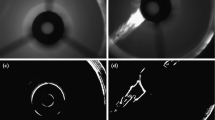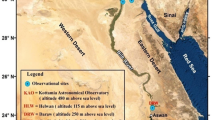Abstract
For the future development of Chinese Giant Solar Telescope (CGST) in Western China, a new sky brightness monitor (SBM) has been produced for the site survey for CGST. To critically examine the performance and sensitivity of SBM, we used it in the observation of the annular solar eclipse in Dali City, Yunnan, on 15 January 2010. The observation met good weather conditions with an almost clear sky during the eclipse. The SBM measurement translates into the solar illuminance changes at a level of 2.4×10−4 I s−1 during the eclipse. The time of the minimal sky brightness in the field of view (FOV) is found consistent with the time of maximum eclipse. Two local sky regions in the FOV are chosen to make a time series of the calibrated skylight profiles. The evolution of the sky brightness thus calibrated also shows good consistency with the eclipse, particularly between the second and the third contacts. The minimal sky brightness in each local sky region took place within half a minute from the corresponding predicted contact time. Such small time delays were mainly caused by occasional cirri. The minimal sky brightness measured during the eclipse is a few millionths of I ⊙ with standard deviation of 0.11 millionths of I ⊙. The observation supports that the single-scattering process (optically thin conditions) is the main contributor to the atmospheric scattering. We have demonstrated that many important aerosol optical parameters can be deduced from our data. We conclude that the new SBM is a sensitive sky photometer that can be used for our CGST and coronagraph site surveys.







Similar content being viewed by others
References
Chandrasekhar, S.: 1950, Radiative Transfer, Oxford Univ. Press, London, 5.
Evans, J.-W.: 1948, J. Opt. Soc. Am. 38, 1083.
Fang, C.: 2011, Res. Astron. Astrophys. 11, 1377.
González Jorge, H., Martinez Pillet, V., Vázquez, M., Pallé, P., McGovern, F., Raes, F.: 1998, New Astron. Rev. 42, 515.
Henyey, L.-G., Greenstein, J.-L.: 1941, Astrophys. J. 93, 70.
Huang, J.: 2008, J. Spacecr. TT&C Technol. 27, 61.
Keil, S.-L., Rimmele, T.-R., Keller, C., Hill, F.: 2000, Bull. Am. Astron. Soc. 32, 1433.
Lin, H., Penn, M.-J.: 2004, Publ. Astron. Soc. Pac. 116, 652.
Liu, N., Liu, Y., Shen, Y., Zhang, X., Cao, W., Jean, A.: 2011a, Acta Astron. Sin. 52, 161 (in Chinese).
Liu, N., Liu, Y., Shen, Y., Zhang, X., Cao, W., Jean, A.: 2011b, Chin. Astron. Astrophys. 35, 428.
Livingston, W.C.: 2000, In: Cox, A.N. (ed.) Allen’s Astrophysical Quantities, Springer, London, 355.
Martinez Pillet, V., Ruiz Cobo, B., Vǎzquez, M.: 1990, Solar Phys. 125, 211.
Penn, M.-J., Lin, H., Schmidt, A.-M., Gerke, J., Hill, F.: 2004a, Solar Phys. 220, 107.
Penn, M.-J., Lin, H., Tomczyk, S., Elmore, D., Judge, P.: 2004b, Solar Phys. 222, 61.
Švestka, Z.: 1976, Solar Flares, Reidel, Dordrecht, 13.
Acknowledgements
The authors thank the referee and the editor for many useful suggestions which improved the manuscript. This work has obtained encouragements and assistance from many colleagues. We thank especially Hai-sheng Ji, Hui Li, Bai-rong Zhang, Ming-chan Wu, Ke Lou, Zhong Liu, Jun Lin, Lei Yang, Hou-kun Ni, and Haiying Zhang for discussion and support. This work is supported by the Natural Science Foundation of China (Grant Nos. 10933003, 11078004, and 11073050) and the National Key Research Science Foundation (MOST 2011CB811400).
Author information
Authors and Affiliations
Corresponding author
Rights and permissions
About this article
Cite this article
Liu, Y., Shen, YD., Zhang, XF. et al. Using a New Sky Brightness Monitor to Observe the Annular Solar Eclipse on 15 January 2010. Sol Phys 279, 561–572 (2012). https://doi.org/10.1007/s11207-012-0012-y
Received:
Accepted:
Published:
Issue Date:
DOI: https://doi.org/10.1007/s11207-012-0012-y




